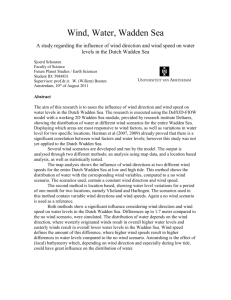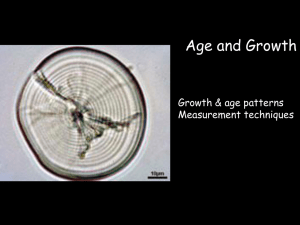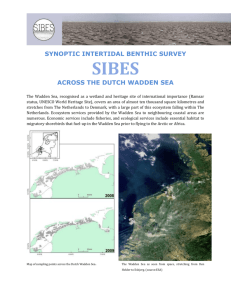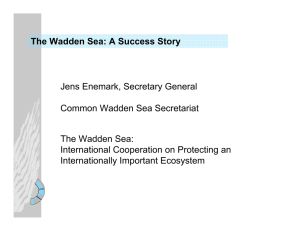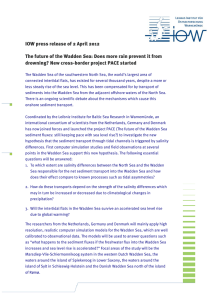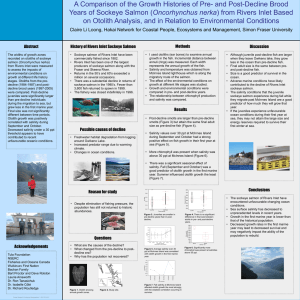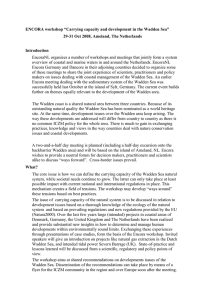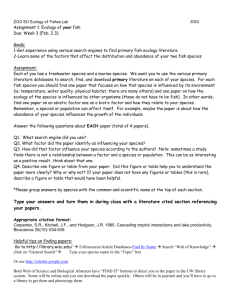Dynamics and growth of the eelpout Wadden Sea Zoarces viviparus Natalia Mendez
advertisement
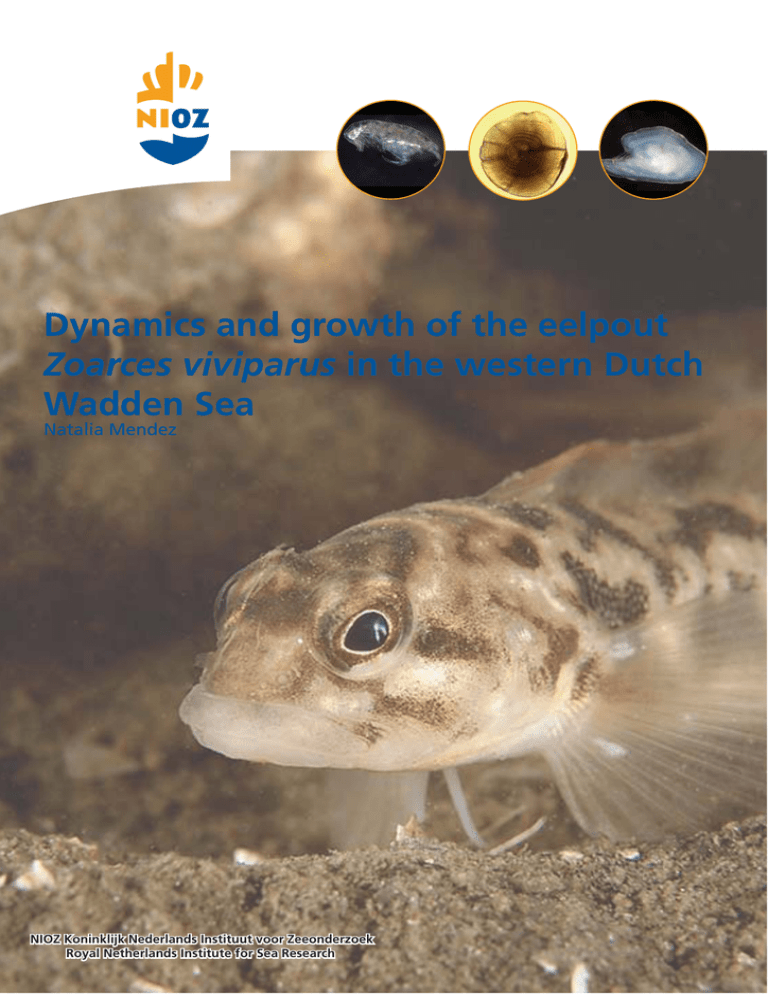
Dynamics and growth of the eelpout Zoarces viviparus in the western Dutch Wadden Sea Natalia Mendez NIOZ Koninklijk Nederlands Instituut voor Zeeonderzoek Royal Netherlands Institute for Sea Research Dynamics and growth of the eelpout Zoarces viviparus in the western Dutch Wadden Sea Natalia Mendez Royal Netherlands Institute for Sea Research Supervised by: Joana F.M.F. Cardoso Vânia Freitas Hans Witte Henk W. van der Veer To be quoted as: Mendez, N., 2014. Dynamics and growth of the eelpout Zoarces viviparus in the western Dutch Wadden Sea. NIOZ-Report 2014-2: 30 pp. Contents Acknowledgements 3 Abstract 4 Introduction 5 Materials and Methods 6 Study area 6 Data acquisition 6 Abundance 7 Otolith growth and morphometry 9 Growth 10 Feeding ecology 10 Results 11 Long-term trends in abundance 11 Otolith growth and morphometry 14 Growth 16 Feeding ecology 18 Discussion 18 Long-term trends in abundance 18 Otolith growth and morphometry 20 Growth 21 Feeding ecology 23 References 24 Supplementary information 30 2 Acknowledgements I am very grateful to Joana Cardoso, Vânia Freitas, Hans Witte and Henk van der Veer from the NIOZ for their supervision, advice and support during the whole project, and for reviewing this report. I also want to thank Siem Gielis, Marco Kortenhoeven and Willem Jongejan for sampling fyke fish, and Sarina Jung for providing eelpout samples and information about the INFOWEB project. I also would like to thank the University of Navarra which funded my grant and especially to Marie Anne Reynell, Milagros Laquidain and Rosario Mancini for their support. Finally, I want to thank Robert Manzano Rubio and Vanesa Nieto Moreno for all their support, help and good advice. 3 Abstract In the past the eelpout Zoarces viviparus was considered a resident fish species in the western Dutch Wadden Sea but nowadays it has become rare. In this study, we analysed population dynamics and growth of Z. viviparus in this area and tried to relate it to changes in environmental factors, such as temperature and salinity. In addition, otolith growth patterns were analysed in order to accurately estimate age, an essential requirement to study growth. Long-term trends in abundance showed a drastic population decline since the early 1970s, probably as a consequence of the increment of mean seawater temperature. Spring abundance showed significant relationships with temperature and salinity in the previous winter and summer, while autumn abundance was related to summer temperature and temperature and salinity in the previous winter. Since growth and reproduction of Z. viviparus seem to be affected by high temperatures, the observed increasing trend in mean annual water temperature in the western Dutch Wadden Sea suggests that temperatures may be less favourable now than in the past. Otolith analysis showed that the population is mostly comprised of individuals up to 5 years old. Growth curves fitted with a Von Bertalanffy growth model differed between sexes with females having lower L and higher K than males. An interannual comparison of summer growth conditions for 0-group Z. viviparus showed that young eelpout reach a larger size at the end of the growing season in recent years than in the past. This suggests that despite the low abundances and increasing temperatures, eelpout growth during the first year of life is not negatively affected. A descriptive analysis of eelpout stomach contents in 2009 showed that its diet is mainly composed of small crustaceans, mostly amphipods and small crabs. 4 Introduction The viviparous blenny, or eelpout Zoarces viviparus (Linnaeus 1758) is a boreal species, typical of north European coastal waters, occurring from the English Channel to the White Sea, including the Baltic Sea (Draganik and Kuczynski, 1993; Svedäng et al., 1997; Ojaveer et al., 2004; Hedman et al., 2011). The southern Wadden Sea (Dutch and German areas) is the southernmost distribution limit of this species (Fonds et al., 1989; Pörtner et al. 2001). This non-migrating demersal fish is mainly found in sheltered habitats in estuaries and shallow coastal areas up to 10 meters deep (Pörtner et al., 2001; Hedman et al., 2011), although a maximum depth of 40 meters has been reported (Kristoffersson and Oikari, 1975). The eelpout is ovoviviparous, i.e. reproduction occurs through internal fertilization of the eggs which occurs around August (Kristoffersson and Oikari, 1975; Goetting, 1976; Hedman et al., 2011). Between December and February, females give birth to about 40–250 fully developed fry of ca. 35 mm long (Kristoffersson and Oikari, 1975; Gercken et al., 2006). Adults reach 20 to 40 cm long and have a life span of about 5 to 14 years (Kristofferson and Oikari, 1975; Ojaveer, 1962). Z. viviparus has minor commercial value but is an important prey item for birds, larger fish and sea mammals (Hario, 2001; Carss et al., 2003; Lehikoinen, 2005; Lundström et al., 2007). Due to their sedentary behaviour, this species has been extensively used as bioindicator of pollution (Hedman et al., 2011 and references therein; Bergek et al., 2012). Adults and fry are also regularly used in experimental studies testing the effects of contaminant exposure on growth, reproduction and mortality (Hedman et al., 2011 and references therein). Despite being a cold water species, Z. viviparus is considered to be eurythermic, tolerating a wide range of temperatures, from 0–20°C with an optimum temperature of about 12–14°C (Brodte et al., 2006; Freitas et al., 2010). Nevertheless, longterm data from the German Wadden Sea (1954-1989; Tiews, 1990; Tiews and Wenbeck, 1990) and a Scottish estuary (1982-2001; Greenwood et al., 2002) showed a decrease in abundance of eelpout coinciding with higher mortality in hot summers. Laboratory studies showed that increasing temperatures caused oxygen limitation leading to reduced growth and fecundity (Pörtner and Knust, 2007). The underlying mechanism seems to be a mismatch between the demand for oxygen and the capacity of oxygen supply to tissues at the thermal extremes (Pörtner and Knust, 2007). Increasing water temperatures due to climate change may therefore have a negative effect on Z. viviparus populations, especially at its southern distributional range. In this paper we analyse a long-term data set of population dynamics of Z. viviparus in the western Dutch Wadden Sea. Mean annual temperature in this area has been increasing since the 1970s (Van Aken, 2008a, 2010), suggesting unfavourable environmental conditions for growth and reproduction of Z. viviparus. During the last decade, mean summer water temperature was around 18°C, reaching even 21°C in some months (Van Aken, 2008a; Van 5 Aken, pers. comm.). Therefore, we hypothesise that the overall conditions for Z. viviparus population productivity (e.g. growth and abundance) in the area have declined in recent years. To understand the fluctuations in abundance over the course of time, the effect of temperature and salinity was examined using an available time-series. Seasonal growth rates of young-of-the-year eelpout were also determined to investigate whether warmer conditions in recent years have affected juvenile growth. In addition, otolith formation patterns were analysed to accurately estimate age, an essential requirement to study growth. These were compared with the age determination method developed for the Baltic Sea (Svedäng et al., 1997). Materials and methods Study area The Dutch part of the Wadden Sea belongs to an international wetland ecosystem that has been designated as a UNESCO World Heritage Site in 2009. With 4700 km2 of intertidal flats it is among the world’s largest intertidal systems. The western Dutch Wadden Sea is recognized as an important nursery and feeding ground for several fish species (Zijlstra, 1972; Fonds, 1978; Bergman et al., 1988, 1989; Van der Veer et al., 1991, 2001) and serves as breeding and wintering area for millions of migratory birds (Reise et al., 2010). Data acquisition Data used by this study originate mostly from multiple monitoring programmes in the western Dutch Wadden Sea, one long-term (and still ongoing) temporal series and several short spatial surveys (Fig. 1). Data available cover the periods 1960 up to now (for a description of the program see Van der Veer et al., 2014), 1963/1964 (Fonds, 1978), 1986 (Van der Veer and Witte, 1993), 2009/2010 (Van der Veer and Witte, 1993) and 2014 (similarly as done by Kuipers, 1977). Additionally, occasional sampling was done in 2011 and 2012 as part of small projects. In all programmes, catches were sorted out immediately and species were identified, counted and measured. Since 1973, catch sub-samples were also analysed for sex and age; and in 2009 and 2010, stomach contents were sampled. Daily water temperature and salinity were obtained from a long-term monitoring program at the NIOZ sampling jetty, located in the vicinity (< 1 km) of the NIOZ fyke (Van Aken, 2003). 6 Figure 1. Map of Marsdiep and Vlie tidal basins in the western Dutch Wadden Sea where sampling was conducted in different cruises over the various years. Different colour shades indicate different depths and the various systems: intertidal, subtidal and gully. Abundance Data from the long-term series starting in 1960 up to now were used to calculate the total numbers of Z. viviparus caught per year during spring (April – June) and autumn (September – October). Generalized additive modelling (GAM) (Hastie and Tibshirani, 1990; Faraway, 2006; Zuur et al., 2007) was used to describe the temporal trends in abundance and to compare between seasons (spring and autumn). Poisson GAMs were fitted to the abundance data using the mgcv (Wood, 2006) package in R (R Core Team, 2014). A quasi-Poisson error structure was employed to account for overdispersion (c.f. McCullagh and Nelder, 1989), as the data set comprised a large number of observations with very low abundances. Two models were compared, whereby the explanatory variables considered were season (nominal) and year (fitted as a smoother): Abundancei = Į + offset (LogFi) + f(yeari) + factor(seasoni) + İi [1] Abundancei = Į + offset (LogFi) + f1(yeari) + f2(yeari) x factor(seasonautumn,i) + factor(seasoni) + İi [2] 7 where Į is an intercept, f is the smoothing function and İi is the residual. Model [1] assumes that both seasons have the same abundance-year relationship, i.e., one smoothing curve is used for both seasons. In model [2], the first smoother (f1(yeari)) represents the overall year effect in both seasons while the second smoother (f2(yeari)) represents the deviation in autumn from the overall abundance-year relationship. To adjust for differences in fishing effort between years and seasons, the natural log-transformed number of days fished (LogFi) was used as an offset variable. Because in 1967 and 2012 no fishing was done in autumn, these years were excluded from the analysis. The smooth functions were constructed as penalized (thin plate) regression splines, with automatic selection of the effective degrees of freedom during the fitting process (Wood, 2006). The effects of temporal autocorrelation were investigated by analysing the residual autocorrelation function (ACF). No temporal autocorrelation was detected in any of the models. An F-test (Wood, 2006) was applied to compare the two models. Time series of temperature and salinity were used to examine whether Z. viviparus abundance was related to changes in these environmental variables. For that, an index for winter and summer was calculated respectively as the mean of December, January and February, and the mean of July and August (Supplementary information Fig. S1). The influence of temperature and salinity on Z. viviparus spring and autumn abundances, from 1961-2013, was analysed with generalized additive modelling, similarly as described above. The general model structure for each season was: Abundancei =Į + offset (LogFi) + σ ݂ ሺܼ ሻ + İi [3] where ݂ are smooth functions of the explanatory variables, and ܼ is the value of the explanatory variable ݇ per observation i. Analysis for Z. viviparus spring abundances considered seawater temperature and salinity from the previous winter and the previous summer. Analysis for Z. viviparus autumn abundances considered seawater temperature and salinity from the summer and the previous winter. Correlations between explanatory variables (collinearity) were assessed by multiple pair-wise scatter plots (pairplots). A forward selection procedure was used (following Zuur et al., 2009), whereby the starting point was a GAM with only one explanatory variable, which was fitted x times depending on the number of different variables (e.g. 4 times for spring abundances). Different models were compared in terms of the generalised cross-validation (GCV) scores (Wood, 2006). The model with the lowest GCV was then used in a next GAM with two explanatory variables, by adding each of the remaining variables to the model (resulting in for e.g. 3 models with 2 variables for spring). This selection procedure was continued until a combination was found which resulted in higher GCV than the previous (simpler) model, resulting on the selection of the simpler model. The effects of 8 temporal autocorrelation were investigated as described above whereby no autocorrelation was detected in any of the selected models. Otolith growth and morphometry Identifying the timing of formation of opaque and translucide bands, and thus the season of otolith growth and growth stop, is important for a correct age determination. Therefore, otolith growth patterns were followed during the first year of life using individuals from 2009/2010 and 2014. Otoliths from successive months were analysed and the deposition of material was noted (Fig. 2) and later compared to fish growth. In addition, otolith length and weight were measured and relationships with fish length were determined. For that, otoliths were weighed individually in a precision balance (0.001 mg), and the longest dimension between the rostrum and posterior part was measured with an ocular micrometer mounted on a stereomicroscope (0.1 mm), assuming that there were no differences between left and right otoliths. Length-weight relationships were expressed as W = a * Lb whereby W is the weight, L the total length, and a and b regression parameters. The relationship between otolith length and fish length was determined by least-squares linear regression. All tests were done in R. Figure 2. Otolith structure of Z. viviparus assumed to be 3 years old (caught in spring). 9 Growth Individual age was determined based on annual growth increments on Z. viviparus sagittal otoliths collected from 1973 onwards. Otoliths were removed, cleaned and depending on the clarity of the increment pattern, either the left or right otolith was chosen for analysis. The selected otolith was submerged in a black vat with water with the sulcus facing down, and observed under a stereomicroscope using reflective light. Annual rings (annuli) were identified as the combination of opaque (indicating spring/summer growth) and translucide (indicating autumn/winter growth) bands alternating around a central nucleus. Counts were made by two readers and whenever the age obtained from two readings differed, the otolith was reexamined by both readers to make a final decision. In cases of disagreement, the otolith was excluded from further analyses. The transition between age groups was set as the 1st of January. Growth curves were fitted to length-at-age data with the Von Bertalanffy growth model (VBGM) using the traditional version of the model developed by Von Bertalanffy with modifications by Beverton (1954) and Beverton and Holt (1957) (Cailliet et al., 2006): Lt = L * (1 - e-K*(t-t0)) [4] whereby L is the estimated maximum total length (cm), K is the growth coefficient (a measure of the rate at which maximum size is reached; yí1), t is age (y), t0 is the theoretical age at zero length and Lt is the observed length at age t. Growth was examined separately for females, males, and all individuals together (including both sexes, immature and undetermined sex specimens). For analysis of sex-specific growth differences in model parameters, different models were compared with a likelihood ratio test, using the ‘vblrt’ function from the library ‘fishmethods’ in R. Comparison of growth parameters of the Von Bertalanffy curve with those described for other Z. viviparus populations was performed using the growth performance index ĭ (ĭ=log10K + 2*log10L) described by Pauly and Munro (1984). Growth was also determined for Z. viviparus juveniles (0-group) based on changes in the mean total length over time from field trawl catches. Absolute growth and average length increment per day was determined for 1964, 1986, 2009 and 2010 and compared between years. Feeding ecology Feeding patterns were studied based on stomach content analyses. For that, digestive tubes of fish collected in 2009 and preserved in formaldehyde were used. Stomachs were separated, weighed (full and empty) using a precision balance (0.0001 g), and contents were analysed under a stereomicroscope. Each prey item was identified at a general level and counted. 10 Percentages of the occurrence of different taxonomic groups were estimated and photographs of well-preserved items were taken. Results Long-term trends in abundance Abundances of Z. viviparus in spring and autumn are presented in Fig. 3, together with model predictions. Maximum abundances were observed in 1965 with a total of about 750 individuals caught in spring and 250 in autumn. From then on, the population strongly decreased until 1973. During the following years, small-scale variations were observed although very low abundances were maintained until now. In 2002 and 2008-2010 no individuals were caught in spring, and in 1998, 2000-2003, 2005-2009 and 2011 no individuals were caught in autumn. Figure 3. Z. viviparus abundance in spring and autumn (total numbers of fish caught per season) in the western Dutch Wadden Sea. Full lines are GAM model predictions (according to model [1]) and striped lines represent 95% confidence intervals. Generalized additive modelling revealed that abundances did not differ significantly between seasons (ANOVA; model [1]: F1,93=0.19, p=0.66; model [2]: F1,88=1.05, p=0.31). The overall year effect (represented by the same smoother for both seasons) indicated that 11 there was a significant year effect on the abundance of Z. viviparus (ANOVA; model [1]: F9,93=76.93, p<0.001; model [2]: F9,88=61.94, p<0.001). In addition, the yearly pattern of abundance was different between seasons (i.e. the abundance-year pattern in autumn significantly differed from the overall pattern in model [2]: ANOVA, F5,88=2.58, p=0.02). Comparison of models [1] and [2] showed significant differences between models (ANOVA, F5,88=3.43, p=0.007), confirming that abundance-year patterns differed between seasons. Figure 4. Partial plots showing smoothers, with 95% confidence limits, fitted to (partial) effects of the predictor variables retained in the final model of spring abundance of Z. viviparus in the western Dutch Wadden Sea. Initial exploratory data analysis on the explanatory variables influencing Z. viviparus abundances in spring and autumn revealed no strong collinearity between the selected explanatory variables (r<0.43 for spring and r<0.44 for autumn). The final model for spring included the effects temperature and salinity in the previous winter and previous summer. This model explained 93% of the deviance (adjusted r2=0.95). Spring abundance showed a strong relationship with summer temperature and salinity of the previous year (Fig. 4, Table 1). Spring abundance decreased with an increase in summer temperature and increased at salinities between 28 and 32. A significant relationship was also found between spring abundance and temperature and salinity in the previous winter (Fig. 4, Table 1). 12 Figure 5. Partial plots showing smoothers, with 95% confidence limits, fitted to (partial) effects of the predictor variables retained in the final model of autumn abundance of Z. viviparus in the western Dutch Wadden Sea. Abundance decreased at mean temperatures above 2°C and increased with increasing salinity. The final model for autumn included the effects summer temperature, and temperature and salinity in previous winter (Fig. 5, Table 1). This model explained 77% of the deviance (adjusted r2=0.74). Autumn abundance was associated with summer temperatures and salinity in the previous winter (Table 1). Abundance showed a strong relationship with temperature in the summer and previous winter. Abundance decreased with increasing summer temperature and highest abundance occurred at winter temperatures of ~2°C. A significant positive relationship was found between autumn abundance and salinity in the previous winter, with abundance increasing linearly with increasing salinity (Table 1). 13 Table 1. GAM results for the selected spring and autumn Z. viviparus abundance models along with their estimated degrees of freedom (Edf), F-statistics and pvalues. Variable Edf F p-value Spring s(prev_summerT) 7.88 7.84 <0.001 s(prev_summerS) 4.15 2.86 <0.001 s(prev_winterT) 5.81 4.61 <0.01 s(prev_winterS) 1.69 4.47 <0.05 Autumn s(summerT) 4.15 9.56 <0.001 s(prev_winterT) 7.74 4.11 <0.001 s(prev_winterS) 1.00 6.09 <0.05 Otolith growth and morphometry Analysis of otoliths from young-of-the-year fish revealed that new-born individuals caught in January and February showed only a central opaque ring (Fig. 6). These otoliths were 0.57±0.05 mm length (mean±SD) in January and 0.63±0.04 mm in February, corresponding to an average fish length of 3.7±0.5 cm and 3.9±0.3 cm, respectively. During the following months, the otolith grew and the deposition of opaque material continued until August. In August/September the first translucide band began to be deposited (Fig. 7). The deposition of the translucide band continued until the end of following spring and an opaque band started forming around June continuing until the end of the summer. For age estimation of Z. viviparus from the Dutch Wadden Sea, we therefore considered that an annual cycle comprised one translucide band and one opaque band (Fig. 8). Figure 6. Z. viviparus otolith of a new-born individual caught in January 2014 (length 0.64 mm). 14 Figure 7. Z. viviparus otoliths of 0-group and I-group (otolith on the right) from July, August, September, October and March (from left to right). Fish total length ranged between 9.5 and 13.6 cm. Figure 8. Annual growth increments observed in Z. viviparus otoliths from 1 to 5 years old. Length-weight relationships of otolith and fish length against otolith weight, and the linear regression between otolith length and fish length are presented in Fig. 9. Otoliths included in this analysis ranged from 1.0 to 3.5 mm length and weighed between 0.23 and 3.81 mg. Positive allometric relationships were found between otolith weight (OW) and, respectively, fish length (FL; OW=0.012*FL1.62, =267, adj. r2=0.74) and otolith length (OL; OW=0.359*OL1.77, n=244, adj. r2=0.72). A strong linear relationship was found between otolith length and fish length (OL=0.35+0.096*FL, n=341, adj. r2=0.84). 15 Figure 9. Otolith weight-fish length, otolith weight-otolith length and otolith length-fish length relationships for Z. viviparus from the western Dutch Wadden Sea. Growth Population growth In total, 332 individuals ranging from 6.5 to 31.5 cm total length were aged by otolith analysis. The maximum age found was 7 years. Significant differences in model parameters L, K and t0 were found between males and females (likelihood ratio test; L and K: p<0.001; t0: p<0.01). Males had a higher L (d.f. = 106; L= 30.4 cm, 95% C.I.: 26.5-41.2 cm) and a lower K (K = 0.35 y-1, 95% C.I.: 0.18-0.53 y-1) than females (d.f. = 130; L= 26.5 cm, 16 95% C.I.: 24.9-29.3 cm; K = 0.56 y-1, 95% C.I.: 0.41-0.73 y-1) (Fig. 10). The estimated t0 was -0.76 and -0.41 y for males and females, respectively. Parameters for males and females were also compared excluding the oldest individual, a 7 year-old female, showing that model parameters were still significantly different between sexes (not shown, for all parameters p<0.001). For comparison with published literature, VBGM parameters were also estimated considering all individuals (males, females, immature and specimens of undetermined sex) which resulted in: L = 26.0 cm, K = 0.62 y-1 and t0 = -0.28 y (d.f. = 341; not shown). The calculated growth performance index ĭ was 2.59 for females, 2.51 for males and 2.62 considering all individuals. Figure 10. Estimated Von Bertalanffy growth curves of Z. viviparus in the western Wadden Sea, based on otolith analysis (females - grey; males - black). Growth in the first year The comparison of seasonal growth patterns of 0-group Z. viviparus between cruises showed some differences between past (1964, 1986) and recent (2009, 2010) years with respect to the start and length of the growing season. Shifts in peaks in length-frequency distributions indicate that in 1964 and 1986 growth was generally similar with young eelpout growing from around 5 cm in April to about 11 cm in October, corresponding to the end of their first growth season (Fig. 11). Daily growth rates estimated over this period resulted in 0.040 mm d-1 and 0.029 mm d-1 in 1964 and 1986, respectively. In 2009 and 2010, at the time of the first sampling (April-May), juvenile Z. viviparus had already a mean length of 8 cm (in 2009) and 9 cm (2010) reaching 12-13 cm in October (Fig. 11). This would result in daily growth rates of 0.018 and 0.031 mm d-1 for the two years, respectively. However, since sampling started after the growing season has started these values are probably underestimations of actual growth rates in the field. 17 14 1964 1986 2009 2010 12 Length (cm) 10 8 6 4 2 0 30 60 90 120 150 180 210 240 270 300 330 360 Day of the Year Figure 11. Change in mean length (cm) over the first year of eelpout Z. viviparus life estimated based on length-frequency data from the surveys carried out in 1964, 1986, 2009 and 2010. Feeding ecology In total, 86 stomachs were analysed from individuals ranging from 6.7 to 23.0 cm total length. Of all stomachs inspected, 20 (about 23%) were empty. Z. viviparus diet consisted mainly of different amphipods such as Gammarus sp., and shore crabs Carcinus maenas (larvae, juveniles and adults). Mussel Mytilus edulis spat were occasionally found, as well as copepods, young shrimps Crangon crangon and cypris larvae. Discussion Long-term trends in abundance The eelpout Z. viviparus was a resident species in the western Dutch Wadden Sea in the 1960s and 1970s, staying in the area throughout the year and during their whole life cycle. However, at present, Z. viviparus is considered rare in this area. A declining trend has been observed since 1970, with especially low abundances (under 10 ind.year-1) since 1980. Such trend is coincident with reports from other areas along the species distributional range, including the Dutch coastal zone (Tiews, 1990; Tiews and Wenbeck, 1990; Greenwood et al., 2002; Tulp et al., 2008). Water temperature is a critical factor determining abundance and distribution of fish species (Marshall and Elliott, 1998; Attrill and Power, 2002; Pörtner and Peck, 2010; Henderson et al., 2011; Pasquaud et al., 2012). Both in the western Dutch Wadden Sea as well as along the whole Dutch coastal zone, an increase in mean annual 18 temperature has been observed since the 1970s, with a significant increase of 0.11°C.y-1 since 1982 (Philippart et al., 2003; Van Aken, 2008a, 2010). During the last decade, mean summer water temperature was around 18°C, and in some months even reached 21°C (Van Aken, 2008a; Van Aken, pers. comm.). Z. viviparus tolerate a wide temperature range (generally 4-18°C), with an optimum temperature for somatic growth of about 12-14°C and an upper lethal temperature of about 21–24°C (Van Dijk et al., 1999; Zakhartsev et al., 2003; Brodte et al., 2006). Increasing temperatures were seen to result in reduced lipid storage, growth and fecundity (Pörtner et al., 2001; Brodte et al., 2008), suggesting that temperatures in the western Dutch Wadden Sea may be less favourable now than in the past. Z. viviparus spring and autumn abundance in the western Dutch Wadden Sea showed a strong relationship with temperatures in the previous winter, with highest abundances between 2 and 4°C. A significantly negative relationship was found between spring and autumn abundance and an increase in summer temperatures. Reduced abundances have been shown to coincide with extreme summer temperatures in the German Wadden Sea and a Scottish estuary (Pörtner et al., 2001; Greenwood et al., 2002). In Sweden, a population decline has also been observed in several areas (Naturvardsverket, 2010a; Naturvardsverket, 2010b), whereby a negative relationship between increasing temperatures and abundance has been observed (Appelberg et al., 2007; Naturvardsverket, 2010b). Salinity is also an important factor structuring estuarine fish communities (e.g. Marshall and Elliott, 1998; Drake et al., 2002; Costa et al., 2007; Henderson et al., 2011; Pasquaud et al., 2012), as a result of different physiological tolerance and habitat preference of species and life stages. Salinity in the previous summer and previous winter were seen to significantly influence Z. viviparus spring abundance, whereas autumn abundance was influenced by winter salinity only. Highest spring abundance was observed at a summer salinity of about 32. In addition, a positive relationship was found between spring and autumn abundance and salinity in the previous winter. This is consistent with field observations on growth of this species in several Swedish sites and the Gulf of Finland, whereby the population from the most saline environment showed highest growth and populations from the lowest salinity levels showed slowest growth (Bergek et al., 2012). In terms of seasonal distribution, Z. viviparus were typically abundant in shallow waters during summer, peaking in May-June and decreasing in October-November (Fonds et al., 1989). Fonds and co-authors (1989) suggested that the increase in 0-group in summer trawl catches was due to a vertical migration to deeper waters to avoid high summer temperatures in the intertidal. In recent years (2009-2010) a slightly different pattern has been observed: although abundances are still higher during summer, numbers were found to decline already in August (not shown). These observations match the reported increase in the frequency of years with zero catches in autumn in the long-term series. 19 Otolith growth and morphometry The present study demonstrates that Z. viviparus otoliths in the western Dutch Wadden Sea do not form the birth ring described by Svedäng and co-authors (1997) for the Baltic Sea. The deposition of opaque material occurs uninterruptedly from birth until August of the next year, when the first translucent ring starts. Therefore, if the method followed by Svedäng and co-authors (1997) would have been used for ageing the Dutch Wadden Sea population, it would lead to an underestimation of the age. The deposition of material in the otolith is an extracellular process directly affected by temperature and other environmental conditions. Low temperatures appear to slow down the chemical and metabolic processes involved in the incorporation of calcium carbonate and organic constituents (Lombarte et al., 1993). However, sea surface temperatures in the western Dutch Wadden Sea and the Baltic Sea are rather similar. Mean temperatures reach highest values in August with average temperatures around 18°C in the western Dutch Wadden Sea (1947-2011 period; Van Aken, 2008a; Van Aken, pers. comm.) and between 16 and 18°C in the Baltic, depending on the location (1990-2010 period; Siegel and Gerth, 2013). The same trend is observed if only the 1990-2010 period is considered for the Dutch Wadden Sea (Van Aken, 2008a; Van Aken, pers. comm.). Temperature is, therefore, probably not responsible for the observed difference in otolith growth patterns between areas. Salinity, on the other hand, is quite different between both areas. In the western Wadden Sea, mean annual salinity varies between ~26 and 32, reflecting large monthly variability in freshwater input due to anthropogenic and natural (e.g., climate) effects (Van Aken, 2008b). In the Baltic, freshwater supply is relatively large and water exchange with the ocean is limited. Average salinity in the 20th century was ~7.4 (Janssen et al., 1999), ranging from 25 to 30 in the Danish Sound area in the south to 1–3 in the inner reaches of the Gulfs of Bothnia and Finland (Bonsdorf and Pearson, 1999). Such salinity values are considered to be too low for marine species but too high for freshwater ones, leading to physiological stress in the most of them (Meier et al., 2006). Previous studies report that salinity can affect the otolith elemental composition (Tzeng, 1995 and references therein; Zimmerman, 2011). Therefore, differences in salinity between western Wadden Sea and Baltic could be responsible for the differences in otolith growth patterns between areas. In addition, differences in diet composition may affect otolith microstructure (Buckel et al., 2004). In the estuarine fish Pomatomus saltatrix, a shrimp-based diet led to higher concentrations of Sr and Ba than a fish-based diet (Buckel et al., 2004). Moreover, in otoliths of the European hake (Merluccius merluccius), opaque and translucide bands were found to have different elemental composition in terms of Ca, Sr and Na (Tomás et al., 2005). Therefore, differences in diet may cause differences in otolith growth patterns. However, in the marine fish Fundulus heteroclitus, water chemistry and not food was the dominant factor controlling the uptake of Sr and Ba in the otoliths (Walther and Thorrold, 2006) suggesting 20 that the relationship between diet and otolith growth patterns is not straightforward. In the Baltic Sea, bivalves are frequently found in stomachs, specially Macoma balthica, Mytilus edulis and Cardium sp. (Ojaveer et al., 2004), while these are rarely found in stomach contents from the Wadden Sea. Instead, herring, gobies and other fish are more frequent prey items of Z. viviparus from the Baltic. These were not found in stomachs from the Wadden Sea, which mainly contained amphipods and crabs. Although the diet analysis carried out in this study seems to suggest that eelpout diet in the Wadden Sea is mainly crustacean-based as opposed to a mollusc- and fish-based diet in the Baltic, we cannot conclude that such difference is responsible for the contrasting patterns in Z. viviparus fry otoliths. Further analysis on the microstructural composition of these otoliths and its relationship with growth band formation is necessary to clarify this aspect. Otoliths retrieved from faeces, regurgitated food or found in stomach contents are used in diet composition studies to identify species, size and numbers of preys consumed (Radhakrishnanet al., 2010). Z. viviparus forms, in some areas, a significant part of the diet of birds and mammals (Carss et al., 2003; Lehikoinen et al., 2011; Lundström et al., 2014), and therefore establishing allometric relationships between otolith measures may be helpful. The strong positive linear relationship found between otolith length and fish length suggests that both parameters follow the same metabolic processes (Ghanbarzadeh et al., 2014). Otolith weight and, respectively fish length and otolith length also showed positive allometric relationships. The fact that the strongest relationship was found between otolith length and fish length, suggests that in this species, otolith length is the most adequate parameter to estimate fish length. However, it should be kept in mind that otoliths might be eroded during the digestion process, which could lead to an underestimation of prey size (Lundström et al., 2014; Jawad et al., 2011). The allometric relationships estimated in this study form a basis for understanding otolith growth in Z. viviparus, and a tool for further studies related to otolith anomalies. Growth Population growth Otolith analysis revealed that the Z. viviparus population in the western Dutch Wadden Sea is dominated by individuals between 0 and 5 years old, confirming that this species uses the area during its whole life cycle, and may therefore be considered a resident species. The estimated L values in this study were lower than predicted for other species using bioenergetics modelling (50 cm for females and 42 cm for males; Freitas et al., 2010) but were not far from the maximum observed size in the area of 30.5 cm for females and 29.5 cm for males (this study). Despite having a lower L, females of 1-3 years old grow faster than males, reaching higher sizes. This might be related to reproductive maturity, which occurs earlier for females, between the first and the second year, than for males (Hedman et 21 al., 2011; Vetemaa, 1999). The estimated L values were also lower than the ones reported for populations from other areas (Table 2), with the exception of the population living in deepsea waters offshore Riga (Table 2). This lower estimated maximum growth observed in the Gulf of Riga may be due to differences in environmental conditions between warm and more productive coastal areas, and cold and less productive in deep-sea areas (Ojaveer et al., 2004) Table 2. Von Bertalanffy growth parameters for Z. viviparus estimated in this and previous studies (adapted from Froese and Pauly, 2014). F refers to females and M to males. All means M, F and undetermined together. All lengths refer to total length. Lf K Gulf of Riga, Estonia (coast) Gulf of Riga, Estonia (deep) 34.0 23.7 0.20 0.29 Pomeranian Bay, Germany 34.5 0.37 Area t0 ĭ Sex References 2.36 2.21 all all 1 1 -0.46 2.65 all 2 Wladyslawowo Bank, Poland 38.6 0.19 -1.23 2.46 all 2 Dutch Wadden Sea 26.0 0.62 -0.28 2.62 all This paper Dutch Wadden Sea 26.5 0.56 -0.41 2.59 F This paper Dutch Wadden Sea 30.4 0.35 -0.76 2.51 M This paper 1Ojaveer and Järv, 2003; 2Wiêcaszek, 1998; The estimated K value was, on the other hand, higher than described in previous studies, indicating a higher growth rate in the western Dutch Wadden Sea. This was, however, expected since L and K are inversely related (Pauly, 1984).The growth performance index ĭ resulted in a relatively high growth performance (2. 62 considering all individuals), similar to the one reported for Pomeranian Bay, Germany, but higher than the ones estimated for Estonia and Poland (Table 2). To our knowledge there are no long-term growth data available for Z. viviparus from other geographic locations and it is, therefore, not possible to assess whether conditions for growth in the western Dutch Wadden Sea are better than in other areas. Growth in the first year Despite the low abundances observed in recent years, eelpout growth during the first year of life does not seem to be affected. In fact, 0-group eelpout reaches a larger size at the end of the growing season compared to the past. This is probably related to environmental temperatures allowing an earlier start of the growth season as well as higher growth rates during spring and summer. Milder winters, when release of the fry occur, have been observed in the last decades (Fig. 12) which, combined with appropriate food conditions, result in extended growing seasons. On the other hand, our results suggest that the larger mean summer temperatures observed in recent years do not seem to be detrimental for 0-group 22 growth. Although experimental evidence on the temperature effect on growth has indicated maximum growth performances at about 15ºC (Fonds et al., 1989), upper critical temperatures are assumed to vary between 21 and 24ºC (Van Dijk et al., 1999) which match environmental conditions periodically reached in the Wadden Sea waters. Figure 12. Mean monthly water temperatures in the western Dutch Wadden Sea at the time of trawling surveys in 1964, 1986, 2009 and 2010. Data was obtained from a long-term monitoring program at the NIOZ sampling jetty, located in the Marsdiep area (Van Aken, 2003). Feeding ecology Z. viviparus is a zoobenthos feeder preying mainly upon amphipods, such as Gammarus sp., and crabs C. maenas (larvae, juveniles and adults). Mussel M. edulis spat, copepods, young shrimps C. crangon and cypris larvae were also occasionally found. Diet composition of Z. viviparus does not seem to have changed significantly in the last years, as described by Fonds (1989), nevertheless the abundance of benthic invertebrates in the western Dutch Wadden Sea decreased over the last half century. Kraan et al. (2010) reported a decrease in crustaceans and molluscs abundance from 1957 onwards. The amphipod Gammarus locusta decreased in numbers, while the amphipods Bathyporeia sp. and Corophium volutator did not show any population growth (Kraan et al., 2010). In addition, according to Beukema (1992), mussel stocks became unprecedentedly low by 1991, probably due to the consecutive recruitment failure from 1988 to 1990 and the unrestricted fishing of mussel spat and adults in 1990, when densities were already low. The decrease in Z. viviparus main prey species from 1957 onwards might be related to its population decline registered during the same period. 23 References Appelberg, M., Andersson, J., Ljunghager, F., Söderberg, K., 2007. Klimatet påverkar kust fiskbestånden. Havet 2007, 28–30. Attrill, M.J., Power, M., 2002. Climatic influence on a marine fish assemblage. Nature 417, 275–278. Bergek, S., Ma, Q., Vetemaa, M., Franzen, F., Appelberg, M., 2012. From individuals to populations: Impacts of environmental pollution on natural eelpout populations. Ecotoxicology and Environmental Safety 79, 1-12. Bergman, M.J.N., Van der Veer, H.W., Zijlstra, J.J., 1988. Plaice nurseries: effects on recruitment. Journal of Fish Biology 33, 201–218. Bergman, M.J.N., Van der Veer, H.W., Stam, A., Zuidema, J.J., 1989. Transport mechanisms of larval plaice (Pleuronectes platessa L.) from the coastal zone into the Wadden Sea nursery area. Rapport et Procès-verbaux des Réunions, Conseil international pour L'Exploration de la Mer 191, 43–49. Beverton, R.J.H., 1954. Notes on the use of theoretical models in the study of the dynamics of exploited fish populations. Miscellaneous Contribution. U.S. Fishery Laboratory, U.S., no. 2, 181 pp. Beverton, R.J.H., Holt, S.J., 1957. On the Dynamics of Exploited Fish Populations. Fishery Investigations, series II. Ministry of Agriculture, Fisheries and Food, London, 533 pp. Beukema, J.J., 1992. Expected changes in the Wadden Sea benthos in a warmer world: lessons from periods with mild winters. Netherlands Journal of Sea Research 30, 73– 79. Bonsdorff, E., Pearson, T.H., 1999. Variation in the sublittoral macrozoobenthos of the Baltic Sea along environmental gradientsδ: a functional-group approach. Australian Journal of Ecology 24, 312–326. Brodte, E., Knust, R., Pörtner, H.O., 2006. Temperature-dependent energy allocation to growth in Antarctic and boreal eelpout (Zoarcidae). Polar Biology 30, 95-107. Brodte, E., Graeve, M., Jacob, U., Knust, R., Pörtner, H.O., 2008. Temperature dependent lipid levels and components in polar and temperate eelpout (Zoarcidae). Fish Physiology and Biochemistry 34, 261–274. Buckel, J.A., Sharack, B.L., Zdanowicz, V.S., 2004. Effect of diet on otolith composition in Pomatomus saltatrix, an estuarine piscivore. Journal of Fish Biology 64, 1469–1484. Cailliet, G.M., Smith, W.D., Mollet, H.F., Goldman, K.J., 2006. Age and growth studies of chondrichthyan fishes: The need for consistency in terminology, verification, validation, and growth function fitting. Environmental Biology of Fish 77, 211–228. Carss, D.N., Elston, D.A., 2003. Patterns of association between algae, fishes and grey herons Ardea cinerea in the rocky littoral zone of a Scottish sea loch. Estuarine Coastal and Shelf Science 58, 265-277. 24 Costa, M.J., Vasconcelos, R., Costa, J.L., Cabral, H.N., 2007. River flow influence on the fish community of the Tagus estuary (Portugal). Hydrobiologia 587, 113–123. Draganik, B., Kuczynski, J., 1993. Spatial distribution of the flounder and viviparous eelpout in the inshore waters of the Gulf of GdaĔsk. ICES C.M./J:13. Drake, P., Arias, A.M., Baldo, F., Cuesta, J.A., Rodríguez, A., Sobrino, I., Silva-García, A., García-González, D., Fernández-Delgado, C., 2002. Spatial and temporal variation of the aquatic nekton and hyperbenthos from a temperate European estuary with a regulated freshwater inflow. Estuaries 25, 451–468. Faraway, J.J., 2006. Extending the Linear Model with R. 1st edition. London: Chapman and Hall/CRC. Fonds, M., 1978. The seasonal distribution of some fish species in the western Dutch Wadden Sea. In Fishes and Fisheries of the Wadden Sea (Hankers, N., Zijlstra, M., Wolff, W.J., eds.), pp. 42-77. Rotterdam: A.A. Balkema. Fonds, M., Jawordski, A., Iedema, A., Puyl, P.V.D., 1989. Metabolism, food consumption, growth and food conversion of shorthorn sculpin (Myoxocephalus scorpius) and eelpout (Zoarces viviparus). I.C.E.S. C.M. 1989/G:31. Freitas, V., Cardoso, J.F.M.F., Lika, K., Peck, M.A., Campos, J., Kooijman, S.A.L.M., Van der Veer, H.W., 2010. Temperature tolerance and energetics: a dynamic energy budgetbased comparison of North Atlantic marine species. Philosophical Transactions of the Royal Society B 365, 3553–3565. Froese, R., Pauly, D., 2014. FishBase. Available at http://www.fishbase.org (last accessed 15 September 2014). Gercken, J., Förlin, L., Andersson, J., 2006. Developmental disorders in larvae of eelpout (Zoarces viviparus) from German and Swedish Baltic coastal waters. Marine Pollution Bulletin 53, 497–507. Ghambarzadeh, M., Soofiani, N.M., Keivany, Y., Taghavi-Motlagh, S.-A., 2014. Use of otolith length and weight in age estimations of the kingsoldier bream, Argyrops spinifer, in the Persian Gulf. Iranian Journal of Ichthyology 1, 1–6. Goetting, K.J., 1976. Reproduction and oocyte-development in Zoarces viviparus (Pisces, Osteichth.). Helgoländer wissenschaftliche Meeresuntersuchungen 28, 71–89. Greenwood, M.F.D., Hill, A.S., McLusky, D.S., 2002. Trends in abundance of benthic and demersal fish populations of the lower Forth Estuary, East Scotland, from 1982–2001. Journal of Fish Biology 61, 90-104. Hario, M., 2001. Chick growth and nest departure in Baltic black guillemots Cepphus grille. Ornis Fennica 78, 97-108. Hastie, T., Tibshirani, R., 1990. Generalized additive models. 1st edition. London: Chapman and Hall. 25 Hedman, J.E., Rudel, H., Gercken, J., Bergek, S., Strand, J., Quack, M., Appelberg, M., Forlin, L., Tuvikene, A., Bignert, A., 2011. Eelpout (Zoarces viviparus) in marine environmental monitoring. Marine Pollution Bulletin 62, 2015-2029. Henderson, P.A., Seaby, R.M.H., Somes, J.R., 2011. Community level response to climate change: The long-term study of the fish and crustacean community of the Bristol Channel. Journal of Experimental Marine Biology and Ecology 400, 78–89. Janssen, F., Schrum, C., Backhaus, J.O., 1999. A climatological data set of temperature and salinity for the Baltic Sea and the North Sea. German Journal of Hydrography 9, 245pp. Jawad, L., Al-Mamry, J., Al-Mamari, H., Manal, Al-Yarubi, M., Haithem, A.-B., 2011. Relationship between fish size and otolith size and weight in the pelagic species Rhynchorhamphus georgi (Valenciennes, 1846) (Family Hemiramphidae) collected from the Sea of Oman. Romanian Journal of Biology 56, 189–200. Kraan, C., Dekinga, A., Piersma, T., 2010. Now an empty mudflat: past and present benthic abundances in the western Dutch Wadden Sea. Helgoland Marine Research 65, 51–58. Kristoffersson, R., Oikari, A., 1985. Notes on the biology of the eelpout (Zoarces viviparus (L.)) in the brackish water of Tvarminne, Gulf of Finland. Annales Zoologici Fennici 12, 143–147. Kuipers, B.R., 1977. On the ecology of juvenile plaice on a tidal flat in the Wadden Sea. Netherlands Journal of Sea Research 11, 56–91. Lehikoinen, A., 2005. Prey-switching and diet of the great cormorant during the breeding season in the Gulf of Finland. Waterbirds 28, 511–515. Lombarte, A., Torres, G.J., Morales-Nin, B., 2003. Specific Merluccius otolith growth patterns related to phylogenetics and environmental factors. Journal of the Marine Biological Association of the United Kingdom 83, 277–281. Lundström, K., Hjerne, O., Alexandersson, K., Karlsson, O., 2007. Estimation of grey seal (Halichoerus grypus) diet composition in the Baltic Sea. NAMMCO Sci. Publ. 6, 177-196. Macdonald, J., Crook, D., 2010. Variability in Sr:Ca and Ba:Ca ratios in water and fish otoliths across an estuarine salinity gradient. Marine Ecology Progress Series 413, 147–161. Marshall, S., Elliott, M., 1998. Environmental influences on the fish assemblage of the Humber estuary, U.K. Estuarine, Coastal and Shelf Science 46, 175–184. McCullagh, P., Nelder, J.A., 1989. Generalized Linear Models. 2nd edition. London: Chapman and Hall/CRC. Meier, H.E.M., Kjellström, E., Graham, L.P., 2006. Estimating uncertainties of projected Baltic Sea salinity in the late 21st century. Geophysical Research Letters 33, L15705. Naturvårdsverket, 2010a. Om miljötillståndet i svenska havsområden. Havet 2010, 116pp. Naturvårdsverket, 2010b. Integrerad kustfiskövervakning i Västerhavet, 2010. Fjällbacka 1989–2009, 15pp. Ojaveer, E., 1962. Riialaheemakalast. AbiksKalurile 24, 12–13. 26 Ojaveer, H., Järv, L., 2003. Eelpout, Zoarces viviparus L. In Ojaveer, E., Pihu, E., Saat, T. (eds.), Fishes of Estonia. Estonian Academy Publishers, Tallinn, 316-323. Ojaveer, H., Eero, M., Lankov, A., 2004. Microevolution of eelpout, Zoarces viviparus, in the Baltic Sea. Proceedings of the Estonian Academy of Sciences, series Biology, Ecology 53, 292–305. Pasquaud, S., Béguer, M., Larsen, M.H., Chaalali, A., Cabral, H., Lobry, J., 2012. Increase of marine juvenile fish abundances in the middle Gironde estuary related to warmer and more saline waters, due to global changes. Estuarine, Coastal and Shelf Science 104– 105, 46–53. Pauly, D., 1984. Fish population dynamics in tropical waters: a manual for use with programmable calculator. ICLARM Studies and Reviews, 8. Manila, Philippines, 325 p. Pauly, D., Munro, J.L., 1984. Once more on the comparison of growth in fish and invertebrates. Fishbyte 2, 2. Philippart, C.J., Hendrik, M., Aken, M.v., Beukema, J.J., Bos, O.G., Cadée, G.C., Dekker, R., 2003. Climate-related changes in recruitment of the bivalve Macoma balthica. Limnology and Oceanography 48, 2171–2185. Pörtner, H.O., Knust, R., 2007. Climate change affects marine fishes through the oxygen limitation of thermal tolerance. Science 315, 95-97. Pörtner, H.O., Peck, M.A., 2010. Climate change effects on fishes and fisheries: towards a cause-and-effect understanding. Journal of Fish Biology 77, 1745-1779. Pörtner, H.O., Berdal, B., Blust, R., Brix, O., Colosimo, A., De Wachter, B., Giuliani, A., Johansen, T., Fischer, T., Knust, R., Lannig, G., Naevdal, G., Nedenes, A., Nyhammer, G., Sartoris, F.J., Serendero, I., Sirabella, P., Thorkildsen, S., Zakhartsev, M., 2001. Climate induced temperature effects on growth performance, fecundity and recruitment in marine fish: developing a hypothesis for cause and effect relationships in Atlantic cod (Gadus morhua) and common eelpout (Zoarces viviparus). Continental Shelf Research 21, 1975-1997. Radhakrishnan, K.V., Liu, M., He, W., Murphy, B.R., Xie, S., 2010. Otolith retrieval from faeces and reconstruction of prey-fish size for Great Cormorant (Phalacrocorax carbo) wintering at the East Dongting Lake National Nature Reserve, China. Environmental Biology of Fishes 89, 505-512. R Core Team, 2014. R: A language and environment for statistical computing. R Foundation for Statistical Computing, Vienna, Austria. URL http://www.R-project.org/. Reise, K., Baptist, M., Burbridge, P., Dankers, N., Fischer, L., Flemming, B., Oost, A.P., Smit, C., 2010. The Wadden Sea – A universally outstanding tidal wetland. Wadden Sea Ecosystem. Common Wadden Sea Secretariat, Wilhelmshaven, no. 29, 7–24. 27 Siegel, H., Gerth, M., 2013. Sea surface temperature in the Baltic Sea in 2012. HELCOM Baltic Sea environment fact sheets. Online (accessed 27 May 2014). http://www.helcom.fi/baltic-sea-trends/environment-fact-sheets/. Svedäng, H., Ojaveer, H., Urtans, E., 1997. Interpretation of the otolith structures in viviparous blenny Zoarces viviparus. Journal of Applied Ichthyology 13, 137–142. Tiews, K., 1990. 35-jahres-trend (1954–1988) der häufigkeit von 25 fisch- und krebstieren an der deutschen Nordseeküste. Archiv fur fischereiwissenschaft 40, 39–48. Tiews, K., Wenbeck, H., 1990. Grundlagen material zu 35-jahres-trend (1954–1988) der häufigkeit von 25 fisch- und krebstieren an der deutschen Nordseeküste. Veröffentlichungen des Instituts für Küsten- und Binnenfischerei 103, 64 pp. Tomás, J., Geffen, A.J., Millner, R.S., Piñeiro, C.G., Tserpes, G., 2006. Elemental composition of otolith growth marks in three geographically separated populations of European hake (Merluccius merluccius). Marine Biology 148, 1399–1413. Walther, B.D., Thorrold, S.R., 2006. Water, not food, contributes the majority of strontium and barium deposited in the otoliths of a marine fish. Marine Ecology Progress Series 311, 125–130. Tulp, I., Bolle, L.J., Rijnsdorp, A.D., 2008. Signals from the shallows: in search of common patterns in long-term trends in Dutch estuarine and coastal fish. Journal of Sea Research 60, 54–73. Tzeng, W.-N., 1995. Effects of salinity and ontogenetic movements on strontium:calcium ratios in the otoliths of the Japanese eel, Anguilla japonica Temminck and Schlegel. Journal of Experimental Marine Biology and Ecology 199, Ill-122. Van Aken, H.M., 2003. 140 years of daily observations in a tidal inlet (Marsdiep). ICES Marine Science Symposia 219, 359–361. Van Aken, H.M., 2008a. Variability of the water temperature in the western Wadden Sea on tidal to centennial time scales. Journal of Sea Research 60, 227–234. Van Aken, H.M., 2008b. Variability of the salinity in the western Wadden Sea on tidal to centennial time scales. Journal of Sea Research 59, 121-132. Van Aken, H.M., 2010. Meteorological forcing of long-term temperature variations of the Dutch coastal waters. Journal of Sea Research 63, 143–151. Van der Veer, H.W., Witte, J.IJ., 1993. The ‘maximum growth/optimal food condition’ hypothesis: a test for 0-group plaice Pleuronectes platessa in the Dutch Wadden Sea. Marine Ecology Progress Series 101, 81-90. Van der Veer, H.W., Bergman, M.J.N., Dapper, R., Witte, J.IJ., 1991. Population dynamics of an intertidal 0-group flounder Platichthys flesus population in the western Dutch Wadden Sea. Marine Ecology Progress Series 73, 141–148. 28 Van der Veer, H.W., Dapper, R., Witte, J.IJ., 2001. The nursery function of the intertidal areas in the western Wadden Sea for 0-group sole Solea solea (L.). Journal of Sea Research 45, 271–279. Van der Veer, H.W., Dapper, R., Henderson, P.A., Jung, A.S., Philippart, C.J.M., Witte, J.IJ., 2014. Long–term changes of the marine fish fauna in the temperate western Dutch Wadden: degradation of trophic structure and nursery function. Estuarine Coastal and Shelf Science (submitted). Van Dijk, P.L., Tesch, C., Hardewig, I., Pörtner, H.O., 1999. Physiological disturbances at critically high temperatures: a comparison between stenothermal antarctic and eurythermal temperate eelpouts (Zoarcidae). The Journal of Experimental Biology 202, 3611-3621. Vetemaa, M., 1999. Reproduction biology of the viviparous blenny (Zoarces viviparus L.). Fiskeriverket 1992, 81–96. Wiêcaszek, B., 1998. On the morphometry and growth rate in the viviparous eel-pout, Zoarces viviparus (Zoarcidae) from waters of different salinity. Italian Journal of Zoology 65, 211-214. Wood, S.N., 2006. Generalized additive models: an introduction with R. Florida: Chapman and Hall/CRC. Zakhartsev, M.V., De Wachter, B., Sartoris, F.J., Pörtner, H.O., Blust, R., 2003. Thermal physiology of the common eelpout (Zoarces viviparus). Journal of Comparative Physiology B-Biochemical Systemic and Environmental Physiology 173, 365-378. Zijlstra, J.J., 1972. On the importance of the Waddensea as a nursery area in relation to the conservation of the southern North Sea fishery resources. Symposium of the Zoological Society of London 29, 233–258. Zimmerman, C.E., 2011. Relationship of otolith strontium-to-calcium ratios and salinity: experimental validation for juvenile salmonids. Canadian Journal of Fisheries and Aquatic Sciences 62, 88-97. Zuur, A., Ieno, E.N., Smith, G.M., 2007. Analyzing ecological data. NY: Springer. Zuur, A., Ieno, E.N., Walker, N., Saveliev, A.A., Smith, G.M., 2009. Mixed effects models and extensions in ecology with R. NY: Springer. 29 Supplementary information: Figure S1. Mean temperature and salinity long-term trends in winter and summer in the western Dutch Wadden Sea. 30 NIOZ Royal Netherlands Institute for Sea Research is an Institute of the Netherlands Organization for Scientific Research (NWO). NIOZ Texel Landsdiep 4 1797 SZ ’t Horntje, Texel Postbox 59 1790 AB Den Burg, Texel Nederland Telephone: +31(0)222 - 369300 Fax: +31(0)222 - 319674 NIOZ Yerseke Korringaweg 7 4401 NT Yerseke Postbox 140 4400 AC Yerseke Nederland Telephone: +31(0)113 - 577417 Fax: +31(0)113 - 573616 www.nioz.nl NIOZ Report 2014-2 The mission of NIOZ is to gain and communicate scientific knowledge on seas and oceans for a better understanding and sustainability of our planet, to manage the national facilities for sea research and to support research and education in the Netherlands and in Europe.
